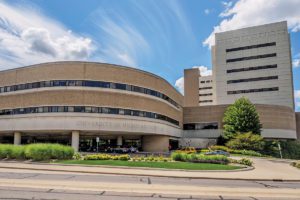GlaxoSmithKline delivered the bad news in February: as of April 1, it was cutting Michigan Medicine off.
The pharmaceutical giant didn’t quite put it that way, of course. Its letter simply announced that starting this month, “GSK will ship products purchased at the 340B price exclusively to locations registered as a 340B covered entity or child site location affiliated with that covered entity.” Translated from the bureaucratese, it meant more bad news for Dana Habers.

Without its outpatient drug profits, the health system would have lost $142 million last year. Photograph by Mark Bialek | markbialek.com
The Michigan Medicine administrator had spent the winter of 2020−2021 on the U-M’s Covid-19 vaccine and therapeutics task force, overseeing vaccine rollout for staff and for the community. It was a highly stressful job she nevertheless calls “the experience of a lifetime.”
Habers is now the health system’s interim chief operating officer for pharmacy. There, she faces a challenge more fiscal and political than medical.
Over the last decade, Michigan Medicine has become financially dependent on an obscure drug discounting program known as “340B,” for its section number in the 1992 federal legislation that created it. The goal was to help health systems with high numbers of Medicaid patients, but rather than increase the government’s reimbursement, it required manufacturers to give them steep discounts on drugs they prescribe for their outpatients. Health systems with more than 11.75 percent of their patients on Medicaid or SSI can buy certain expensive drugs for 30 percent or more off. They then bill insurers for the standard price and pocket the difference.
At U-M, 340B drug savings—effectively, profits—rose from zero in 2004, when it first qualified for the discounts, to $170 million in fiscal year 2016, to $482 million last year, according to documents obtained through a Freedom of Information Act request. That amounts to almost ten percent of the health system’s total revenues. Without it, instead of a $340 million surplus last year, Michigan Medicine would have run a $142 million deficit.
—
How did the U-M manage to increase its 340B income by more than $300 million in just five years? There were three main drivers, says Habers: the tendency of very expensive infused and injected “specialty” drugs to find new disease indications; fast-rising drug prices; and contracting with hundreds of outside pharmacies to deliver prescriptions.
For example, the injectable drug Humira first hit the market in 2002 for rheumatoid arthritis. FDA approval to treat psoriatic arthritis came in 2005 and for Crohn’s disease in 2007. It’s now approved for eight different diseases and brings in $20 billion a year for its manufacturer, AbbVie. A year’s worth of Humira last year cost about $84,000, so the U-M pocketed tens of thousands of dollars for each patient receiving it—the difference between full insurance reimbursement it received and the heavily discounted 340B price it paid AbbVie.
Secondly, drug prices have been rising much faster than inflation, and the higher the price of a given drug, the greater the absolute dollar value of its U-M 340B discount. (Humira’s list price rose 7.4 percent in January.)
Finally, the U-M aggressively expanded its network of outside pharmacies contracted to dispense 340B-discounted drugs to Michigan Medicine patients, from seventy stores in 2016 to 576 stores in 2021. These savings, too, flow to the U-M (less a fixed fee per claim paid to the pharmacy).

U-M Health president David Miller says the discounts “stretch scarce resources to meet the needs of our patients and our communities.” Photograph courtesy of U-M Health
U-M isn’t unique—hospitals nationwide are getting record 340B profits. Now they’re facing a backlash. In 2018 and 2019 the Trump administration cut nearly 30 percent from Medicare outpatient drug payments for many 340B hospitals, including the U-M.
“It was a sizable reduction,” says Laura Appel, a policy specialist at the Michigan Health and Hospital Association. The Biden administration maintained the cuts, even after the American Hospital Association sued to restore full funding. It’s a measure of its importance that the case has gone all the way to the U.S. Supreme Court. The justices have already heard arguments and will rule on the case by the end of the court’s current term in June.
The change “has impacted us” to some extent, says Habers. “It’s one of many things that could either grow or impact us more materially in the future, depending on how the Supreme Court decides.”
A bigger hit is coming directly from Big Pharma, which has long resented the discounts it’s forced to give to 340B hospitals. “The [drug] industry has gotten to the point of: enough is enough,” says Stephen Rapundalo, president and CEO of the Michigan Biosciences Industry Association (and a former Ann Arbor city councilmember). “We’re bearing the brunt of this, it’s on our bottom line, and the system is not operating the way Congress is intending.”
GSK is just the latest drug maker to opt out. In brazen defiance of government rules, thirteen others, including AbbVie, Eli Lilly, and Merck, have unilaterally ended 340B discounts for most drugs dispensed through contract pharmacies.
As more companies defect each month, “it seems to be a wave,” says Habers, “We’ve already had a [negative] impact this year to our operating margin of about $30 million.”
This dispute, too, is working its way through the courts. One issue is whether the government had the authority to require the discounts without new legislation. Another is whether pharmacies and their hospital partners have stayed true to the original intent of the program, which was to make drugs cheaper and more available to uninsured patients and to those who lack easy pharmacy access.
Rapundalo says he doesn’t know enough to comment on the U-M’s program, but he believes most 340B hospitals and their contract pharmacies aren’t using 340B as intended. “They basically have coopted a program that’s meant to help patients and turned it into one that boosts their bottom lines, with little if any of the benefits being passed on to the intended patients,” he says. For-profit chains like CVS “are making massive profits from it.”
Patient access to their prescriptions is seldom at stake. David Miller, president of U-M Health, acknowledges that pharmacies could still dispense drugs to the U-M’s patients without a 340B contract. But, he says, “there’s a link—the ability to stretch scarce resources to meet the needs of our patients and our communities.”
The savings realized from all these prescriptions, Habers says, indirectly permit a variety of U-M programs that help vulnerable patients, including making pharmacy technicians part of the standard care team for all patients, helping them obtain their prescriptions most affordably, and addressing their drug-related problems. “We’re adding pharmacists,” he says, and patient financial counselors—“pharmacy tech-trained individuals to help patients navigate co-pays and authorizations and out-of-pocket costs.”
340B revenues also flow to the University of Michigan Medical Group (UMMG), the faculty group practice that collects physician payments and distributes them. These allocations are often contentious, with various clinical departments clamoring for a greater share or fighting off cuts imposed from above. Miller, among his other duties, oversees the UMMG.
“Our financial performance supports our mission, reflected in our strategic plan,” he says. “And [340B] allocation is reflected according to those priorities and I think very consistent with patient benefit, community impact, population impact, and long-term sustainability around our whole tripartite mission” of patient care, research, and education.
—
Hospitals are now negotiating with drug companies towards some kind of resolution. “We keep pushing on it, and they keep pushing back,” says Appel. In the meantime, more drug companies could join the stampede of defectors, leaving the U-M and its contract pharmacies paying the standard price for their drugs, too.
The vast majority of U-M’s contract pharmacies are chains like CVS and Rite Aid, and those seem to be a particular target of the manufacturers’ ire. GSK’s letter emphasizes that it will extend discounts to no more than one contract pharmacy at only a single location.
The drug companies argue that the 340B program in general has gotten out of control. “There’s … no real guardrails to ensure that the intended patient population, i.e. the low-income folks, are truly receiving the benefits the program was designed to provide,” says Rapundalo. Hospitals are not required to earmark their 340B profits for such programs, and there’s little transparency, Rapundalo adds.
Michigan Medicine, for its part, uses its 340B savings appropriately, says Miller—to benefit patients. U-M provided the Observer with figures showing $19 million in charity care and write-offs of unpaid bills in 2020. That figure is dwarfed by the 340B profits and is actually down from 2016. However, the “unpaid cost of government programs” line item ballooned from $273 million in 2016 to $587 million in 2020.

MichBio president Stephen Rapundalo objects that chains like CVS “are making massive profits from it” at his members’ expense. Photograph by Mark Bialek | markbialek.com
Much of that is the shortfall between what it costs Michigan Medicine to care for Medicare and Medicaid patients and what the government actually reimburses. Miller says that Medicaid patients make up 16 percent of the U-M’s patient population and Medicare patients 39 percent.
“The 340B program is designed to essentially subsidize the fact that Medicaid reimbursement rates aren’t enough to actually provide the care,” says Habers. “That [gap] is closed, rather than through additional taxpayer dollars and government programs, it’s closed through a discount on pharmacy, through big pharmaceutical manufacturers.”
These growing reimbursement shortfalls make Michigan Medicine even more dependent on 340B and vulnerable to any further erosion of the program. That prospect may explain a project that was due to go before the U-M board of regents as the Observer went to press in March: a $52 million plan to fill more prescriptions in-house.
The proposal, signed by Michigan Medicine CEO Marschall Runge and U-M CFO Geoffrey Chatas, asked the regents to approve the purchase of the former Thomson-Shore printing plant—a 144,000-square-foot building on twenty-five acres just outside Dexter.

Fourteen pharmaceutical companies have ended their discounts to Michigan Medicine for specialty prescriptions filled by other pharmacies. Now the health system wants to double the number it can fill itself by buying this former printing plant in Dexter. Photograph by Mark Bialek | markbialek.com
About one-third of the building would be immediately repurposed “to house an expansion of our specialty and mail order pharmacy program,” Runge and Chatas wrote. “This investment is required for the growth of Specialty Pharmacy services to more than double the number of prescriptions we fill per year through our in-house pharmacy and better meet the needs of our patients.”
The rationale for expansion “is based on providing high quality, convenient care for all patients and achieving progress through multi-disciplinary collaborations,” they added. “We are committed to accelerating change and promoting a positive patient experience in a competitive market, driving innovative health care delivery models.”
It would also, they wrote, “contribute to financial sustainability across Michigan Medicine, in support of the tripartite mission.”
—
There’s no explanation of why the health system’s patients might soon need twice as many specialty prescriptions filled in-house. But if more pharmaceutical manufacturers join the wave and eliminate 340B discounts on sales through those hundreds of contact pharmacies, the withdrawal symptoms for Michigan Medicine will be painful: some departments will be forced to make cuts or to set aside plans for expansion. It’s easy to imagine why its leaders might want to insure against that risk.
Expanding outpatient specialty pharmacies “is a trend that we are seeing across the country,” emails Aaron Vandervelde, a Washington, D.C.–based health care consultant (and U-M business school grad). Though it predates the pharmaceutical companies’ rebellion, he writes, “my guess is that [drug] manufacturer policies may have accelerated the trend … There is a lot of money in this business—same as for contract pharmacy operations.”
If the Dexter facility enables Michigan Medicine to fill twice as many prescriptions in-house, it will avoid the fees it now pays contract pharmacies to fill them. It would also minimize the risk that if the manufacturers prevail, those sales could be lost entirely.
By late summer of 2023, Michigan Medicine employees could be at work there, filling prescriptions for patients and sending them out for delivery. If that $52 million investment ends up saving hundreds of millions of dollars a year in income, it will be money well spent.